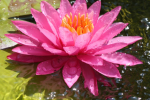Do not be anxious about your life.
—Matthew 6:25
Everything in life teaches us something about what it is to be human until, if we are listening and learning all our lives, we ourselves become everything we can possibly be. We begin the search for fullness of life at a very early age. We choose heroes, icons of what we ourselves would like to become.
All the heroes of my early life were people of action. I valued explorers, presidents, civil rights activists, suffragettes, friends and family members who were brave enough, decisive enough, strong enough to make things happen. It was only as I got older and people I loved began to die that I discovered the lesson, the courage of calm:
Uncle Lou faced cancer in the ’50s when it was the scourge of modern medicine, but talked to me quietly and gently about my own future two days before he died.
Sister Theophane closed her eyes in the middle of pain, smiled and slipped into a period of comatose waiting after a lifetime of competence and efficiency.
My mother, a brilliant woman, suffered the ravages of Alzheimer’s disease for 28 years and went from its early forms of agitation to a kind of distant inner existence untroubled by anybody or anything.
In each of those situations a kind of chaos infected the world. Yet, at the same time, each of them brought with it a new kind of insight. No doubt about it: the lesson I learned from death was the lesson of calm. After all, what use was flailing and raging when life went inevitably on? Or, as the case may be, would not go on at all.
The problem, of course, lies in learning to determine when calm is courageous and when chaos is holy. When is acceptance holy and chaos madness; when is chaos holy and acceptance weakness? Maybe we never know. But that’s not important. What is important is to keep asking the question and to develop the ability to be both resolutely calm and courageously holy as the situation demands.
There is a kind of calm that is passive acceptance of the unacceptable. When the world around us is falling mercilessly on the backs of people who cannot bear the burden or did not cause the destruction, to be calm in the midst of evil is not a good. Then, we must do something. But calmly.
To spend life worrying about what we cannot control or do not know with certainty will happen makes a mockery of faith and a shell of hope.
“Never cut what you can untie,” Joseph Joubert wrote. We rush where we could walk and we run where we do not need to go. And when we get there, there’s nothing left inside of us to bother to have brought.
What we do with too much haste we live to regret. What we do with reflection we can respect all our lives.
Life is not a Gordian knot; it is not a problem to be solved. Life is a process to be lived in the surety that, in the end, things will, if we allow them, come out just as they should.
Calm is only a virtue when it implies stability in the face of chaos, not when it is simply an excuse for refusing to act. That’s not calm, that’s “becalmed.” There’s not a sailor in the world who doesn’t know the difference.
What is the use of being agitated? It serves only to irritate the spleen, not to resolve the problem.
There comes a moment in life when we finally realize that most of what we worry about is not worth the worry. Then, the calm sets in, the synonym for which may well be maturity.
Apathy is not calm. To be resigned to what must be changed is simply complicity with evil.
When we understand the dimensions of a situation with all its dangers, all its risks, all its demands, calmness is the only thing that will keep us ready to face it, able to survive it, come what may.
Calm and resignation are not the same thing. Resignation is what’s left when we don’t stay calm enough to do the right thing in the first place.
“Calmness,” Ralph Waldo Emerson wrote, “is always Godlike.” If you are God, you know that life always goes “wrong.” The question, of course, is, What is really "right"? Better to go through the process calmly till the storm ends and the skies are brighter than to fly into a panic and miss the new moment completely.
The old hymn reminds us, “Be still my soul” in times of distress. Then, and only then, when we stay still and listen can we hear the voices of wisdom around us, both within and without.
The Irish have a phrase for it: They call hysteria “losing the run of yourself.” The implications of the statement are clear. When we lose our calm, we lose the best of ourselves to wild gesturings that lack both substance and direction.
Calmness is not an affectation of public propriety. It is a state of inner peace that is impervious to the winds of change around us.
The old “stiff upper lip”—the ability to pretend that nothing has affected us when something certainly has or certainly must—is a poor imitation of the calm that comes from believing that whatever we are forced to face in life can be dealt with without being destroyed by it.
Never be afraid of chaos. It is simply order rearranging itself.
Chaos is the foundation of creativity. “Every act of creation,” Pablo Picasso says, “is first an act of destruction.” Until one system falls, another can never rise. That’s why saving a dying past only prolongs the inevitable.
“Adopt the pace of nature,” Emerson writes. “Her secret is patience.” We are not a patient people, we Americans. We believe more in the instant than in the coming. We make hysteria one of the hallmarks of effectiveness and, in the end, perhaps, mix results with effectiveness.
To be impatient is to miss a lot of beauty, to push a lot of children to become adults too quickly, to become a trade-in society with little or no respect for what, having served well in the past, still has value in the present. We so commonly overlook what only the heart, calm enough to trust the present, can really see.
Driven by a need for results, we miss the sight of trees growing and flowers opening and relationships becoming. We push and prod and commit ourselves to a kind of “progress” that misses a lot of life because we are not calm enough to let a thing develop through every necessary stage from slim beginning to satisfying end.
Why go through a thing calmly when you can wear yourself out before the project even begins by going into a panic about it? Then it won’t really make any difference whether it succeeds or not. You will have already endured the worst. That’s called the storm before the calm.
“Why are you crying?” the teacher asked the child. “Are your parents mean to you?” “No,” the child said. “My parents are the kindest people in the world.” “Do they neglect you?” the teacher said. “Absolutely not,” the child said. “They play with me and tell me stories every night.” “Do they refuse to get you what you want?” “No,” the little boy went on sobbing. “They get me the best of everything.” “Then why in heaven’s name are you crying?” the teacher asked again. “Because I’m afraid they might try to run away.” Ah, why enjoy what is when you can worry about what might be coming?
There is a kind of chaos that releases possibility. Most people fear an environment that encourages new ideas. They prefer what is because they fear what might be if they’re not in control of it.
The colors we paint our rooms, the types of music to which we choose to listen, the volume at which we play the TV, the degree of clutter in a room, all contribute to the mental state through which we view our world.
If you feel anxious all the time, it might be time to clean out the cupboards, empty the desk drawers, change the flowered wallpaper and sit down somewhere alone. It’s amazing how silence changes the face of chaos, and raises the level of calm in the world.
Road rage is nothing but the loss of personal calm let loose upon the world at large.
When calm is impossible and chaos is the order of the day, try to remember that God created the world out of nothing and, God willing, if we stay at this thing long enough, something may come out of this mess, too. Or as Ella Wheeler Wilcox put it: “The splendid discontent of God with chaos made the world.”
“Concern should drive us into action,” Karen Horney wrote, “not into depression.” There is no virtue in complaining about things we refuse to do something to improve, to change, to open to public examination. That kind of calm only increases the problem.
Pace has become a synonym for progress. As a result we find ourselves rushing from one thing to another, hectic and exhausted, when learning to savor life, to milk the moment, has become the lost art of human development. We must learn to cultivate what Adrian Cowell calls, “the slow rhythm of waiting.”
People who are really interested in raising the level of calm in a discussion and slowing the pace of the world, start by lowering the level of their voices and slowing the speed of their talk.
Let’s Share Our Thoughts
1. Which of these reflections on “anxiety and calmness” was most meaningful or challenging to you? Explain.
2. In her introduction, Sister Joan spoke about the individuals who, as they came to the end of their lives, taught her the courage of calm. She defines calmness as “a state of inner peace that is impervious to the winds of change around us.” (Oct,15) Can you identify a person who has embodied such calmness, someone in your personal life perhaps? A public figure in our nation or the world? Name the person and discuss under what circumstances they embodied such calmness.
3. Reflect on Sister Joan’s entry for October 25th: “The colors we paint our rooms, the types of music to which we choose to listen, the volume at which we play the TV, the degree of clutter in a room, all contribute to the mental state through which we see the world.” Choose one of these examples and share what you believe it says about the positive or negative aspects of your “mental state.”
4. The Scripture for this month is Matthew 6:25: “Do not be anxious about your life.” Discuss what spiritual practices help you cope with anxiety.
5. In her introduction, Sister Joan posed a question for the month: “The problem, of course, lies in learning to determine when calm is courageous and when chaos is holy. When is acceptance holy and chaos madness; when is chaos holy and acceptance weakness?” What have you learned that addresses that question? What are you doing to “develop the ability to be both resolutely calm and courageously holy as the situation demands?”
Let’s Listen to Other Voices
Idea 1
Alison Barr writes in her essay, “A Meditation on Liminal Space,” that, “Liminal space is a place of transition, one where we often feel unsettled or anxious. Life is not as it was before, but we don’t yet know how it’s going to be.”
PROMPT: Describe a time in your life when you were thrust into liminal space, either willingly or not. What upheld you during this period of your life? How did the experience change or transform you?
Idea 2
A mantra is a word or phrase you repeat during meditation as a tool to help calm your mind. While this age-old practice is known to have Buddhist and Hindu roots, forms of “sacred word” recitation exist within a great variety of spiritual traditions, including the Judeo-Christian. Here is an excerpt from The Way of the Pilgrim, written by an anonymous Russian Orthodox monk who repeated the phrase, “Lord Jesus Christ have mercy on me a sinner.” It is said he prayed the words 12,000 times a day until “the pilgrim found the prayer at his lips and in his mind every waking hour, as spontaneous and effortless as his breath itself.”
Sit down in silence. Lower your head, shut your eyes, breathe out gently, and imagine yourself looking into your own heart. Carry your mind, that is, your thoughts, from your head to your heart. As you breathe out, say, "Lord Jesus Christ, have mercy on me." Say it moving your lips gently, or simply say it in your mind. Try to put all other thoughts aside. Be calm, be patient, and repeat the process very frequently. —The Way of the Pilgrim
PROMPT:
Choose three days in a row and begin your day with the mantra “Be still my soul,” saying it over and over while you shower, dress and get ready for the day. Repeat the mantra to yourself often through the day and consciously try to follow its direction. Each evening, journal about how the mantra helped you “stay still and listen to the voices of wisdom around us, both within and without.” If it makes a difference, consider making it a regular pattern in your life.
Let Us Pray
The Serenity Prayer
God grant me the serenity to accept the things I cannot change;
courage to change the things I can;
and wisdom to know the difference.
Attributed to Reinhold Niebuhr
Pray this more than once and reflect on those times when you had such wisdom. You may want to journal your response.
JOAN CHITTISTER
is an internationally known author and lecturer and a clear visionary voice across all religions. She has written more than 60 books and received numerous awards for her writings and work on behalf of peace and women in the church and in society.
HELEN DAVID BRANCATO, IHM
is a painter, printmaker and illustrator whose work carries themes of justice, peace and poverty. An associate professor of art at Villanova University, she has presented workshops on spirituality and compassion around the country. Through painting, Helen David brings the depth of her insight into the pain, strength and dignity of her subjects.

 Artwork: by Helen David Brancato, IHM
Artwork: by Helen David Brancato, IHM




